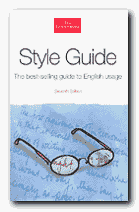best-selling guide to English usage and style rules
The Economist prides itself on good quality writing. The Economist Style Guide is the print version of their in-house guide on grammar and English usage which they issue to all their journalists. It’s designed to promote precision and clarity in writing – and the advice it offers is expressed in a witty and succinct manner. It gives general advice on writing skills, points out common errors and cliches, offers guidance on consistent use of punctuation, abbreviations and capital letters, and contains an exhaustive range of reference material.
 It also includes a special section on American and British English, a fifty-four page fact checker, and a glossary. I particularly like the section called ‘Common Solecisms’ which warns against popular misunderstandings and points to words often used incorrectly.
It also includes a special section on American and British English, a fifty-four page fact checker, and a glossary. I particularly like the section called ‘Common Solecisms’ which warns against popular misunderstandings and points to words often used incorrectly.
Anticipate does not mean expect. Jack and Jill expected to marry; if they anticipated marriage, only Jill might find herself expectant.
The emphasis of the illustrative examples is on current affairs, politics, economics, and business – but the lessons in clear expression and the examples of tangled syntax and garbled journalese will be instructive to all writers who wish to sharpen their style.
It takes quite a tilt at the language of political correctness – and I think some of the following advice might be challenged. But it is so refreshingly un-stuffy, one reads on with a smile in the mind.
Avoid, where possible, euphemisms and circumlocutions promoted by interest-groups. In most contexts the hearing-impaired are simply deaf. It is no disrespect to the disabled sometimes to describe them as crippled. Female teenagers are girls, not women. The underprivileged may be disadvantaged, but are more likely just poor.
The guidance is arranged in logical, separate sections – political terms, metaphors, apostrophes, spelling, Americanisms – so you can easily find what you need. The bulk of the advice deals with common problems of English such as the difference between ‘compare with‘ and ‘compare to‘, but I was glad to see that rather like Keith Waterhouse (Waterhouse on Newspaper Style they do not leave the excesses of their own profession unexamined.
Avoid expressions used only by journalists, such as giving people the thumbs up, the thumbs down or the green light. Stay clear of gravy trains and salami tactics.
© Roy Johnson 2010
The Economist Style Guide, London: Economist Books, 10th edition 2010, pp.272, ISBN: 1846681758
More on journalism
More on creative writing
More on writing skills
More on publishing
Actually, I agree with you completely. And I make it a practice to always include the comma before any final ‘and’ (unless it connects a group, as in ‘fish and chips’).
However, there is never universal agreement on these finer points of grammar and punctuation.
Anybody following the Economist Style Guide is more likely to find their written English improved than otherwise.
Unfortunately, the Economist Style guide adopts some conventions that make language less precise, not more so.
For example, it discourages the use of commas in sentences that contain a series of items (a practice that introduces ambiguity into such sentences).
It exhorts:
“Do not put a comma before and at the end of a sequence of items unless one of the items includes another and. Thus The doctor suggested an aspirin, half a grapefruit and a cup of broth. But he ordered scrambled eggs, whisky and soda, and a selection from the trolley.”
This practice introduces ambiguity as to whether the last two items of a series are actually a group item (as is normally indicated by the conjunction “and”) or to whether they are two independent items in the series. Punctuation is meant to reduce ambiguity; this practice espoused by the Economist serves to increase ambiguity.
In short, it panders to language laziness and cultural conventions even when those conventions degrade linguistic precision. This lessens its worth as a style guide.